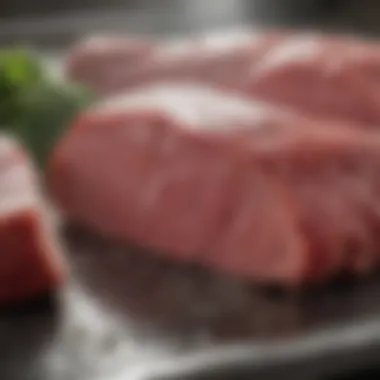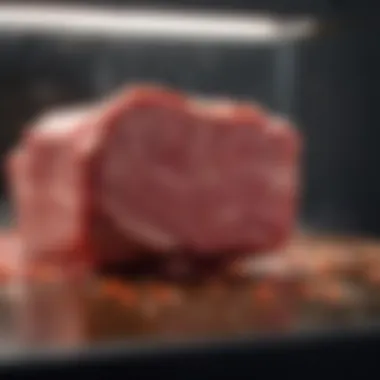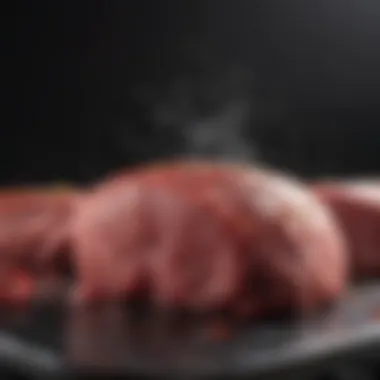Comprehensive Guide to Selecting the Best Meat Defroster


Intro
Defrosting meat is a common challenge in the kitchen, yet it often seems underestimated. Proper defrosting can significantly impact the texture and flavor of your proteins, affecting the final dish. Whether you are a novice cook or a seasoned chef, understanding the nuances of meat defrosters is vital. This guide explores the technology and types available, while providing practical insights into making an informed choice. By following this comprehensive review, anyone can improve their culinary efficiency and promote higher standards in meal preparation.
Recipe Overview
Recipe Name
Perfectly Defrosted Steak
Description of the Dish
This dish begins with a perfectly defrosted steak, ready to be seasoned and cooked according to your preference. The aim is to achieve a juiciness that complements the flavors, ensuring a tender bite that leaves a lasting impression. Proper defrosting is essential to prevent the loss of moisture during cooking, which can lead to a dry result.
Understanding Meat Defrosters
Meat defrosters come in various types, each utilizing different technologies. Understanding these will help you select the best one for your needs. Some methods include microwave defrosting, water bath techniques, and specialized electric defrosters.
- Microwave Defrosting
Quick but can result in uneven defrosting. Requires careful monitoring to avoid cooking edges of the meat. - Water Bath Technique
Submerging in cold water is effective. The main challenge is to ensure the water remains cold enough to prevent bacteria growth. - Electric Defrosters
Some are designed specially to maintain appropriate temperatures, allowing for even defrosting without risking meat quality.
Factors Influencing Effectiveness
Several factors influence how well a meat defroster works:
- Thickness of the meat
- Type of meat (e.g., poultry, beef, pork)
- Temperature of the meat before defrosting
- Method of defrosting used
Understanding these elements can promote better decisions when selecting a defroster. It is essential to think about your cooking habits and the types of meats you frequently prepare.
End
Choosing the right meat defroster is more than a matter of convenience. It is essential to achieving quality results in your cooking efforts. This guide provides the foundational understanding necessary to make informed decisions about defrosting methods and devices. By ensuring your meat is properly defrosted, you can elevate your culinary technique and enjoy better meals.
Preamble to Meat Defrosters
Meat defrosters play a critical role in meal preparation, bridging the gap between frozen and fresh cooking. A proper defrosting technique not only enhances flavor but also retains the meat's natural textures and juices. Understanding the different methods and the importance of correct defrosting can significantly improve one’s culinary experience.
By utilizing effective defrosting practices, one can prevent the common problem of uneven cooking or compromised meat quality. This guide aims to provide a detailed examination of various defrosting methods, helping readers to make informed selections of meat defrosters that align with their cooking needs and preferences.
Understanding the Importance of Proper Defrosting
Defrosting meat properly is essential for both safety and quality. When meat is frozen, ice crystals form inside the muscle fibers. If not thawed correctly, these ice crystals can cause the meat to dry out during cooking, leading to tough or chewy textures.
Moreover, improper defrosting can become a breeding ground for harmful bacteria. When meat is left at room temperature to thaw, it can spend too much time in the danger zone—temperatures between 40°F and 140°F—where bacteria thrive. Employing proper defrosting methods minimizes these risks by ensuring that the meat thaws evenly and safely. For food lovers, the difference in texture and flavor is profound.
Common Methods of Defrosting Meat
There are several ways to defrost meat, each with its own set of advantages and disadvantages. Below are the common methods:
- Refrigerator Thawing: This method is the safest as it keeps meat at a consistent, safe temperature. It requires planning since it can take several hours or even a day, depending on the size of the meat.
- Cold Water Thawing: Submerging packaged meat in cold water is faster than refrigerator thawing. Change the water every 30 minutes to ensure it stays cold. This method is effective but requires more attention.
- Microwave Thawing: Using a microwave is quick if you need to thaw meat in a hurry. However, it can lead to uneven thawing. Parts of the meat may start cooking during the process. Careful monitoring is necessary.
- Cooking from Frozen: Some methods allow cooking meat directly from frozen, but results may vary. This method is often best for smaller cuts.


By understanding these methods, cooks can select the best way to defrost based on their time constraints and equipment availability.
Proper defrosting is not just about convenience; it’s about ensuring quality and safety in every meal.
Types of Meat Defrosters
Understanding the different types of meat defrosters is vital to selecting the right one for your kitchen. Each method has distinct qualities that merit consideration when making a purchasing decision. The main forms include electric defrosters, microwave defrosting, and the water bath method. Each varies in operation and efficiency, making knowledge of their mechanics and effectiveness essential.
Electric Defrosters
How They Work
Electric defrosters typically use heating elements or pads to thaw meat. When plugged in, they generate warmth that gradually raises the temperature of the meat. This method promotes a more uniform thawing process compared to some alternatives. One key aspect of electric defrosters is their ability to maintain a consistent temperature, which can significantly aid in preventing the growth of harmful bacteria during the defrosting process.
Advantages and Disadvantages
The main advantage of electric defrosters is their speed and convenience. They can defrost meat quickly without risking cooking the outer layers. However, not all electric defrosters offer the same features. Some might lack adjustable settings, potentially leading to uneven defrosting if not monitored closely. Additionally, they require an electrical outlet, which may limit their use in some situations.
Microwave Defrosting
Settings and Safety
Microwaves provide a rapid defrosting method using specific settings that control the heat applied to the food. Most microwaves have built-in defrost functions which allow you to select the type of meat and its weight. This adaptable feature aids in safeguarding the meat from beginning to cook. However, caution is necessary, as uneven heating can happen if not managed.
Potential Risks
One notable risk linked to microwave defrosting is the chance of uneven thawing. Certain parts of the meat may begin to cook while others remain frozen. This situation not only affects texture but also raises food safety concerns. Bacteria can proliferate in warmed areas. Therefore, careful monitoring and rotation of the meat are necessary to mitigate this risk.
Water Bath Method
Temperature Control
The water bath method is an effective way to defrost meat using warm water. Instead of direct heat, the water envelopes the meat uniformly, leading to gradual thawing. Keeping the water temperature around 70 degrees Fahrenheit is critical to prevent harmful bacteria from developing. This method requires careful attention not to exceed this temperature, as cooking can occur.
Best Practices
When using the water bath method, follow best practices to ensure safety and efficiency. First, always use a sealed bag to prevent any water from entering the meat. Second, regularly monitor the water temperature. This method can be time-consuming compared to others but can yield better results in terms of texture and flavor retention.
Factors Influencing Defrosting Efficiency
The efficiency of meat defrosting is not solely dependent on the type of defroster used. Several factors play a crucial role in maximizing the effectiveness of the defrosting process, thus impacting the overall quality of the meat once it is prepared. Understanding these elements can significantly enhance the culinary experience. Here, we delve into three specific factors: meat thickness and density, defrosting temperature, and time considerations.
Meat Thickness and Density
The thickness and density of the meat significantly influence the defrosting process. Thicker cuts of meat take longer to defrost than thinner ones. This is important to consider when planning a meal or using a defroster. Denser meats, such as beef, require different defrosting techniques compared to lighter meats, like chicken or fish.
- Impact on Time: A thicker roast may require several hours in a refrigerator or water bath, while thin filets could defrost within a short timeframe.
- Heat Penetration: Heat from the surrounding environment must penetrate the outer layers to defrost the inner portions effectively. If not accounted for, uneven defrosting can lead to a portion of the meat being cooked while another remains frozen, leading to food safety issues.
Defrosting Temperature
The temperature at which defrosting occurs has a significant effect on the safety and quality of the meat. The ideal defrosting temperature is critical to prevent bacterial growth that may occur during the thawing process.


- Optimal Temperature Range: Defrosting in the refrigerator, which maintains a temperature below 40°F (4°C), is the safest method. Though it takes longer, this method ensures that meat stays within a safe temperature range.
- Room Temperature Risks: Defrosting meat at room temperature is not recommended. Temperatures between 40°F and 140°F (4°C and 60°C) can promote bacterial growth, compromising food safety.
"The safest method of defrosting is in the refrigerator, which ensures that meat remains below 40°F (4°C) throughout the process."
Time Considerations
The time it takes to defrost meat is a relay of other factors, including the size of the meat and the method used. Time is not just a number; it is essential for ensuring the meat is defrosted evenly and safely.
- Pre-Planning: Chefs should plan when to start defrosting, especially for larger cuts of meat. For example, a whole turkey might need days in the refrigerator to thaw safely.
- Monitor Time Closely: If using quicker methods such as microwave or cold water baths, monitoring the time is crucial to prevent partial cooking or safety concerns.
Understanding these factors can vastly improve the effectiveness and safety of the defrosting process. Ensuring meat is appropriately thawed not only enhances flavor but also ensures that culinary standards are pressed.
Buying Considerations for Meat Defrosters
When selecting a meat defroster, it is crucial to take into account several key factors. Understanding these buying considerations can significantly enhance the defrosting process and ensure that your meat maintains its quality. Investing in the right meat defroster can lead to more efficient meal preparation and better results in the kitchen. This section outlines the important elements to consider before making a purchase.
Capacity and Size
The capacity and size of a meat defroster play a pivotal role in its usability. For individuals or small families, a compact model may suffice. However, for households that require larger amounts of meat, larger capacity defrosters are advantageous. Consider your typical meat preparation needs. If you often defrost whole chickens or large cuts of beef, opt for a model that can accommodate these sizes comfortably without overcrowding. Undercapacity can lead to uneven defrosting, which affects food safety and quality.
Material Quality and Durability
The material quality and durability of a meat defroster directly impact its lifespan and performance. Look for products made from sturdier materials. Stainless steel and BPA-free plastics are excellent choices as they tend to resist wear and tear over time. Cheaper models may save you money upfront but could end up costing more due to frequent replacements. A well-constructed defroster can withstand daily use, making it a smarter investment in the long run.
Ease of Cleaning
Ease of cleaning is often an underrated aspect but is vital for maintaining hygiene. A defroster that is simple to disassemble and clean will save you time and effort. Look for features such as removable trays or surfaces that can be wiped down easily. Additionally, consider if the material is dishwasher safe. A device that requires less maintenance encourages frequent use, leading to better meal preparation habits.
Remember: Keeping your defroster clean is key to ensuring food safety and preventing cross-contamination when preparing different types of meat.
In summary, when choosing a meat defroster, focus on capacity, material quality, and cleaning ease. These factors greatly influence both the effectiveness and usability of the appliance.
Top Meat Defrosters in the Market
Selecting the right meat defroster is crucial for achieving optimal results in meal preparation. It can make a difference in the texture and flavor of the meat. Different options offer unique advantages that cater to various cooking styles and preferences. Thus, understanding the features of available products is essential for making a wise choice.
Product Recommendations
High-End Options
High-end meat defrosters are designed with advanced technology that ensures quick and safe defrosting. A prominent product in this category is the Defrost Buddy. This electric defroster uses infrared technology to thaw meat evenly and efficiently. The key characteristic of high-end options is their precision; they often come with adjustable temperature controls and specialized settings based on the type of meat.
One unique feature of high-end defrosters is their ability to defrost several types of meat simultaneously without cross-contamination. They are also equipped with safety features that prevent overheating, which can be a concern with other methods. However, the primary disadvantage is the price point, which may be prohibitive for some users.
Budget-Friendly Alternatives
For those on a tighter budget, there are cost-effective meat defrosters that still perform well. An example is the Quick Thaw Defroster Tray. This product utilizes a specially designed aluminum surface to facilitate rapid heat transfer, making it a popular option. The key characteristic of budget-friendly alternatives is their accessibility; they often provide a simple solution without fancy technology.
While they may not defrost food as quickly as their high-end counterparts, their affordability and simplicity make them a favorable choice for many families. A unique feature of these trays is that they do not require electricity, making them a safer option for households where electrical safety is a concern. However, one should be mindful of the fact that they may require more attention, such as flipping the meat midway through the process to ensure even thawing.
User Reviews and Ratings


User feedback is invaluable in evaluating meat defrosters. Consumers often share their experiences on various platforms such as Reddit and Facebook. Positive ratings commonly highlight the efficiency and speed of specific products, while critical reviews might address durability and ease of use.
Overall, gathering insights from user reviews plays a significant role in discerning which meat defrosters are truly effective. A product with a consistent track record of high ratings is often a more reliable choice than one with mixed feedback.
"Choosing the right meat defroster could determine how well your meals turn out. Don’t overlook the power of user reviews."
In summary, whether considering high-end or budget-friendly options, exploring user ratings can provide helpful guidance in selecting the best meat defroster suited to your culinary needs.
Common Mistakes to Avoid
When it comes to selecting and using a meat defroster, understanding common mistakes is critical. These errors can not only affect the efficiency of your defrosting process but can also pose food safety risks. Avoiding these mistakes leads to better results, whether for a casual dinner or a formal meal. Better practices ensure that meat retains its quality and remains safe for consumption.
Overloading the Defroster
One significant blunder many people make is overloading the defroster with too much meat at once. While it may seem like a time-saver, placing an excessive quantity can lead to uneven defrosting. The outer layers might thaw while the internal parts remain frozen. This can result in potential bacterial growth, as partially thawed meat may spend too long in the danger zone or insufficient temperatures.
Here are some key points to consider:
- Thaw in batches: It is best to defrost smaller portions of meat. This ensures each piece thaws evenly.
- Space between pieces: Keep sufficient space to allow proper airflow around each item. This is essential for uniform temperature distribution.
- Consider meat size: Varying thicknesses of meat will require different defrosting times. Larger cuts need more time, while smaller pieces require less.
To avoid this mistake, familiarize yourself with the capacity limits of your defroster. This aligns with the guideline of not exceeding the recommended weight or volume that your appliance can handle efficiently.
Remember, even though it can be tempting to rush the process, the results of careful defrosting are far superior.
Ignoring Food Safety Guidelines
Failing to adhere to food safety guidelines during the defrosting process is a critical mistake. Defrosting meat improperly can facilitate the growth of harmful bacteria. The USDA recommends keeping thawed meat at a safe temperature to prevent spoilage.
Consider these important food safety practices:
- Use Cold Water: If you're using a water bath method, ensure that the water is cold. Warm or hot water can reach a temperature that allows bacteria to flourish.
- Immediate Cooking: Once meat is thawed, it should be cooked right away. Leaving it at room temperature increases spoilage risks.
- Prevent Cross-Contamination: Always use separate cutting boards and utensils for raw meat and other food items. This practice minimizes the chances of transferring harmful pathogens.
By paying close attention to food safety, you minimize health risks. Proper practices not only protect you and your family but also improve the quality of your meals. Avoiding these silly mistakes can lead you to a more successful kitchen experience and impeccable culinary results.
Ending
The conclusion of this guide underscores the significance of selecting the right meat defroster and provides a final perspective on the importance of proper defrosting techniques in culinary practices. By understanding the various types of meat defrosters available in the market, cooks can make informed choices that directly impact the quality of their meals. The convenience and efficiency of using the correct defrosting method can lead to improved flavor and texture in the final dish.
This article has highlighted key factors influencing defrosting effectiveness, such as meat thickness, defrosting temperature, and timing. Recognizing these elements is crucial when choosing a defroster. Additionally, the section on common mistakes emphasizes the importance of food safety, encouraging readers to follow best practices.
Ultimately, this guide serves as a comprehensive resource, assisting both novice and experienced cooks in navigating the world of meat defrosting. Choosing the appropriate defroster not only ensures safe food preparation but also enhances the overall culinary experience.
Summary of Key Points
In summary, the journey through this guide covers essential considerations:
- Types of Defrosters: Electric, microwave, and water bath methods each have unique advantages.
- Factors Affecting Efficiency: The thickness and density of meat, the surrounding temperature, and defrosting duration all play vital roles.
- Buying Considerations: Factors like size, material quality, and ease of cleaning are crucial when selecting a defroster.
- Common Mistakes: Avoiding overloading and adhering to food safety guidelines are vital for success.
Emphasizing these aspects ensures readers are well-equipped to make knowledgeable decisions.
Final Thoughts on Choosing a Meat Defroster
Selecting the right meat defroster is an important step for enhancing cooking skills. It requires careful consideration of multiple factors, including personal cooking habits, the type of meat typically prepared, and kitchen space. Electric defrosters may offer the fastest, most convenient means of defrosting, while traditional methods can still yield excellent results if time allows.
In the age of convenience, it is vital to remember that rushing the defrosting process can lead to uneven cooking and potential food safety risks. Investing in a quality meat defroster not only streamlines meal preparation but ensures that the final dishes retain the desired taste and texture.
As you venture into the world of meat defrosting, keep these insights in mind. The right meat defroster can significantly improve culinary outcomes, ensuring delicious and safe meals for you and your guests.







